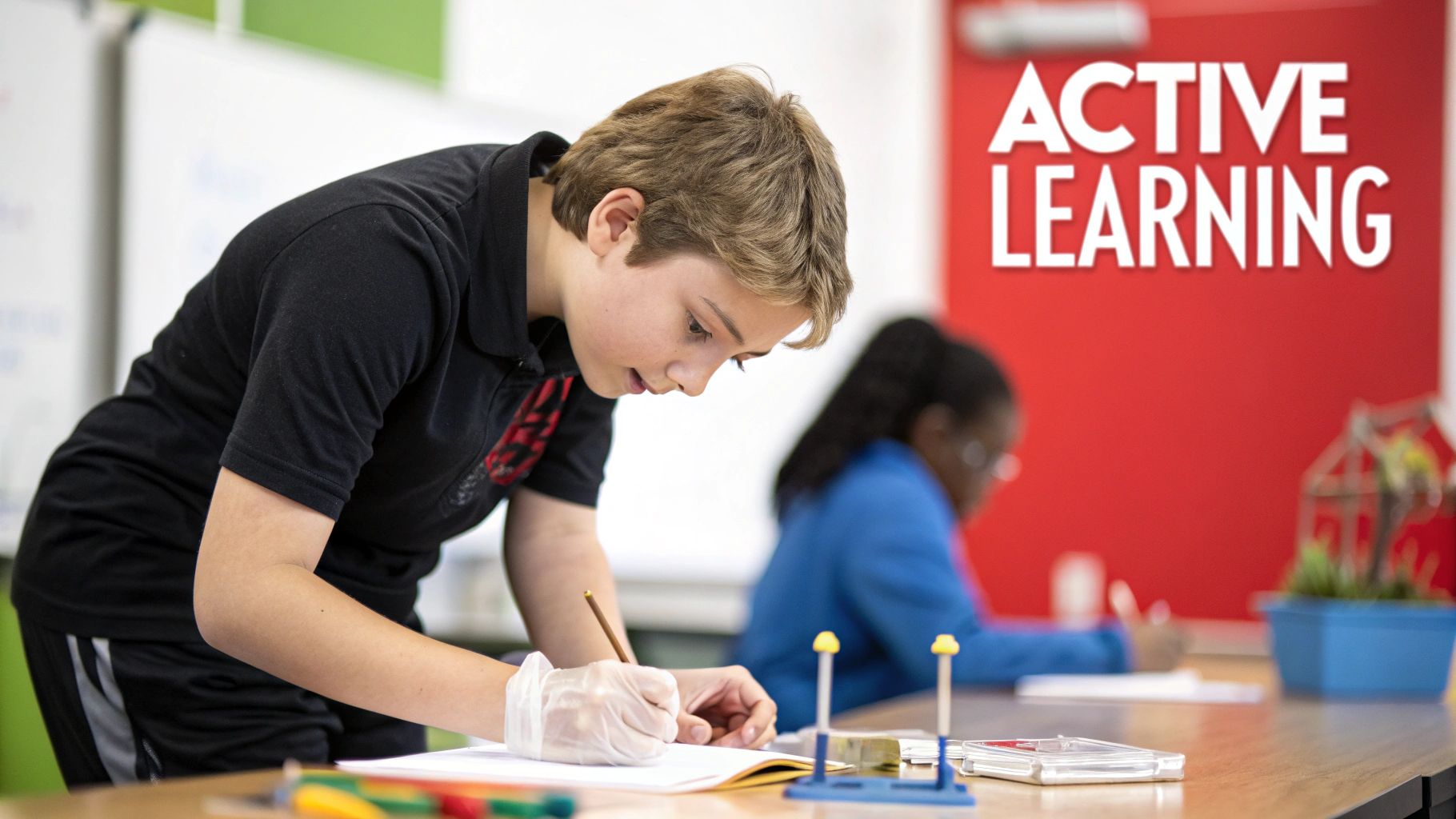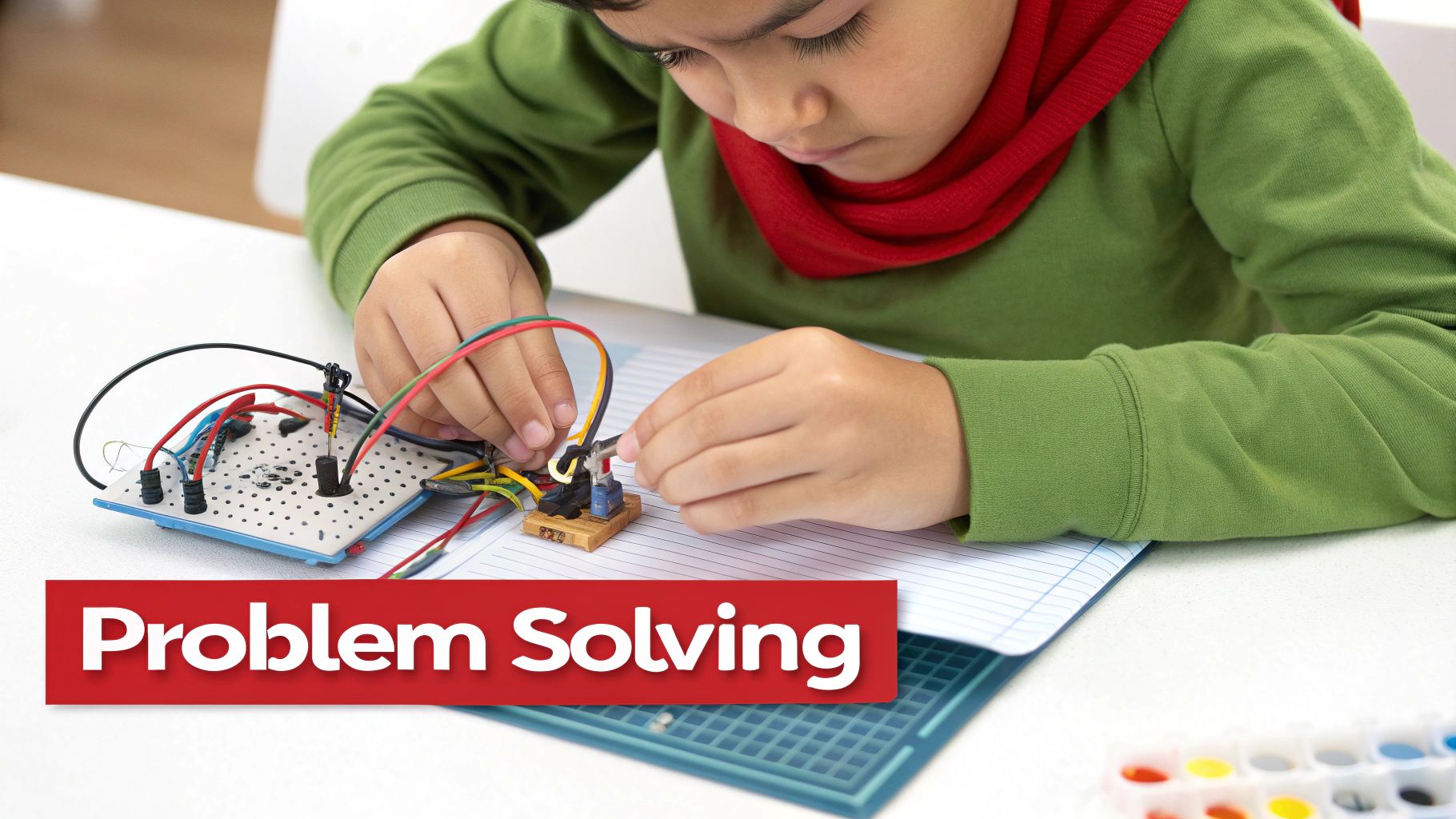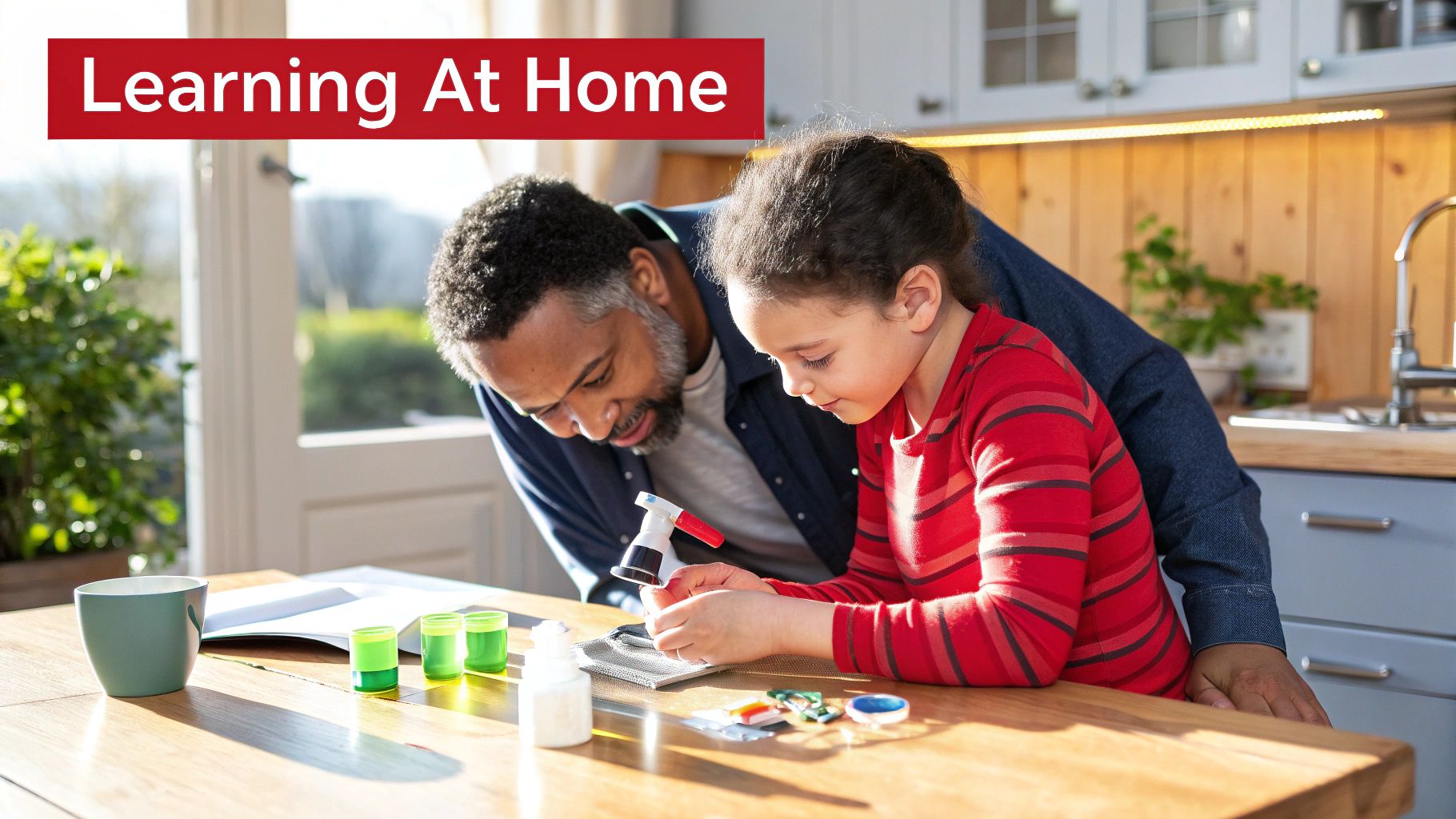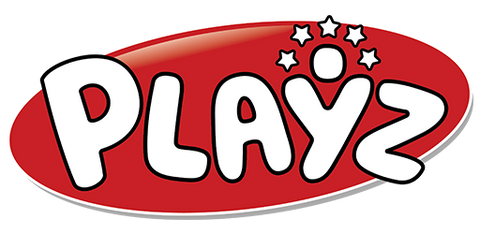
The Real-World Benefits of Hands-On Learning (And Why It Works)
It’s a simple truth, but a powerful one: the biggest benefit of hands-on learning is that it dramatically improves memory retention. At the same time, it builds a deeper, more practical understanding of how things actually work.
Instead of just hearing about a theory or reading a definition in a book, kids who physically engage with a subject form much stronger neural connections. Plain and simple, the knowledge just sticks. This guide breaks down the science-backed benefits of learning by doing and offers practical ways to bring this powerful approach into your child's life.
Why Hands-On Learning Is More Than Just "Doing Activities"
Many people mistake hands-on learning for simple playtime, but it’s a profound educational philosophy. At its heart, it’s about shifting a child from a passive audience member to an active participant in their own education. Learning becomes an act of construction, where knowledge isn't just handed down but is built, piece by piece, through real experience.
Think about learning to ride a bike. You can read a manual or watch videos, but you only truly understand balance, momentum, and steering when you get on and start pedaling. That active approach builds real-world competence.
This infographic does a great job of comparing the active, engaging nature of hands-on learning with more traditional, passive methods.
As you can see, hands-on methods are all about active engagement and problem-solving—two critical drivers for developing skills that last a lifetime.
To give you a clearer picture, here’s a quick breakdown of how these two approaches stack up.
Hands-On vs. Traditional Learning: A Quick Comparison
| Aspect | Hands-On Learning | Traditional Learning |
|---|---|---|
| Student's Role | Active participant, problem-solver | Passive recipient of information |
| Focus | Understanding the "why" and "how" | Memorizing the "what" |
| Engagement | High; students are physically and mentally involved | Varies; often low and passive |
| Key Skills | Critical thinking, problem-solving, collaboration | Rote memorization, note-taking |
| Retention | High; knowledge is tied to experience | Low; information is easily forgotten |
| Outcome | Deep, practical understanding | Surface-level, theoretical knowledge |
The differences are stark. One method builds creators and thinkers, while the other focuses on recall. For lasting knowledge, the choice is clear.
The Foundation of Effective Learning
This approach works so well because it taps into the brain's natural desire to learn through experience. When a child builds a circuit or mixes chemicals to see a reaction, they aren't just following instructions. They're testing a hypothesis, seeing cause and effect unfold, and learning from their mistakes.
This process gives them a few core advantages we'll dive into:
- Boosted Memory: Physical interaction creates stronger, multi-sensory memories that are much easier to recall.
- Enhanced Critical Thinking: Kids must troubleshoot and adapt when things don’t go according to plan, which is where real thinking happens.
- Increased Motivation: Active participation sparks genuine curiosity and makes learning feel relevant, exciting, and fun.
Key Takeaway: Hands-on learning transforms abstract concepts into tangible realities. It bridges the gap between knowing what something is and understanding how it works. This connection is the key to meaningful, lasting education.
This approach is also closely tied to other powerful educational ideas. You can learn more about the incredible play-based learning benefits in our detailed guide, which explores how structured play builds a critical foundation for both academic and social success.
Ultimately, hands-on learning isn't just a "fun alternative"—it's a scientifically-backed path to more effective, engaging, and memorable learning.
How Active Engagement Rewires the Brain for Better Retention
Have you ever wondered why you can remember the steps to a recipe you've cooked a dozen times, but a phone number someone just told you vanishes in seconds? The answer is all about how our brains are wired. Listening to information is fleeting, but doing something builds strong, lasting connections in the brain. This is the real magic behind the benefits of hands-on learning—it literally rewires the brain to understand things on a deeper level.
When a child physically builds something or manipulates an object, they’re firing up multiple senses at once: touch, sight, and even the feeling of movement. This multisensory engagement creates a memory with several anchors, making it far more stable and easier to recall later.
Think of it like this: reading a textbook is like looking at a blueprint. You get the general idea, but the bridge isn't real. Hands-on learning is the act of laying each stone and connecting every cable. You're forging a physical, memorable structure inside the brain.
From Doing to Deep Understanding
This active process does more than make memories stick; it builds genuine comprehension. When kids physically interact with ideas, abstract concepts become concrete. A student doesn't just read about gravity; they feel its pull as they test how different weights affect a catapult they just built.
This is why this learning style is a powerhouse for trickier subjects like science and math. The physical experience provides instant feedback. You try something, it works or it doesn't, and you discover why. That cycle is crucial for developing real understanding, not just cramming facts for a test.
Key Takeaway: The brain prioritizes memories tied to physical action and sensory input. They are flagged as important and stored more permanently than information we just passively hear or see.
The Power of the Kinesthetic Connection
That link between physical movement and memory is the bedrock of kinesthetic learning. For many kids (and adults!), the act of doing is essential for information to truly click. When the body gets involved, the brain snaps to attention, leading to much better knowledge retention. To go deeper, check out our guide on what the kinesthetic learning style is.
The results are incredible. Research shows learners retain about 75% of what they learn when they practice it. That number skyrockets to an amazing 90% when they apply that knowledge immediately. It’s no surprise that a majority of people prefer hands-on training. It’s an intuitive and powerful way to learn, and you can discover more insights about these educational benefits and their impact.
Ultimately, by getting the body moving, we engage the brain on a richer level, turning forgettable information into permanent knowledge. This active approach doesn't just teach a subject; it builds a stronger, more capable mind.
Developing Real-World Problem-Solving Skills
Knowing facts is one thing; knowing how to use them when things get tricky is something else entirely. That’s where hands-on learning truly shines. It shifts kids from remembering information to applying it, turning theoretical knowledge into practical, real-world problem-solving skills.

This approach forces students to think on their feet. Instead of a teacher handing them an answer, they get a problem and the tools to figure it out. This setup naturally pushes them to test their ideas in a safe space where mistakes aren't just allowed—they're a valuable part of the journey.
From Trial and Error to Critical Thinking
Picture a child building a simple circuit with a Playz science kit. The light bulb doesn't turn on. Have they failed? Not at all. They’ve just run into their first troubleshooting challenge.
Now they have to check their work. Are the connections right? Is the battery working? This cycle of trying something, seeing it fail, and figuring out why is the bedrock of critical thinking.
This process teaches how to think, not just what to think. Kids learn to break down big problems into smaller, manageable pieces—a skill that pays off everywhere, from the classroom to their future career.
Key Takeaway: Hands-on learning reframes failure. It’s not an endpoint; it’s just another piece of data. Every mistake guides them closer to the right answer and builds resilience along the way.
The Building Blocks of a Problem-Solver
This active engagement nurtures a set of skills you just don't get from a textbook. By tackling hands-on challenges, kids build a solid foundation for solving any problem that comes their way.
- Systematic Troubleshooting: They learn to spot issues, test one variable at a time, and logically deduce the cause of a problem.
- Creative Solutions: When the first idea doesn’t work, they're encouraged to think outside the box and try something new.
- Adaptability and Resilience: They get comfortable with not knowing the answer right away and learn to adjust their plans based on real-time feedback.
These experiences are fundamental for raising curious and capable kids. To dive deeper, our guide on how to develop problem-solving skills has more great strategies. Ultimately, hands-on learning turns abstract ideas into practical abilities, creating confident and resourceful children.
Sparking Lifelong Curiosity and Intrinsic Motivation
What if learning felt less like a chore and more like an adventure? Traditional learning often puts kids in the spectator seats, which can suck the natural curiosity right out of them.
Hands-on learning flips that script. By putting learners in the driver's seat, it transforms education into a journey of discovery. When kids are actively building, creating, and experimenting, they're not just memorizing—they're exploring.

This shift from passive listening to active doing is a game-changer for motivation. The sense of accomplishment from successfully building a circuit is a powerful reward. It's the "aha!" moment that fuels a genuine desire to learn more.
Turning "Have To" Into "Want To"
One of the biggest benefits of hands-on learning is its power to ignite genuine interest. Abstract STEM concepts can feel distant and boring. But when a child uses a Playz kit to build their own working volcano, the principles of chemistry suddenly become tangible and exciting.
They see the direct results of their actions, creating a positive feedback loop that keeps them engaged. This immediate impact makes learning feel relevant, moving it from the "have to" column of their minds squarely into the "want to" column.
Key Takeaway: When children feel a sense of ownership over their learning, their motivation skyrockets. Hands-on projects give them that control, allowing them to make decisions, test theories, and see their ideas come to life.
This isn't just a hunch. Studies consistently show that hands-on activities lead to better academic outcomes and a major confidence boost. Researchers have noted marked improvements in achievement and critical thinking among kids who learn this way. You can learn more about these motivational findings and see how they impact learners of all ages.
Fostering a Growth Mindset
Hands-on learning is the perfect training ground for a growth mindset—the belief that abilities can be developed through hard work. When an experiment doesn't work on the first try, it's not a failure; it’s a puzzle to solve. This process teaches resilience and perseverance better than any textbook ever could.
This learning style taps into several key drivers of motivation:
- Autonomy: Kids make choices about how to tackle a problem, giving them a sense of control.
- Mastery: Every small success builds a feeling of competence and self-belief.
- Purpose: By solving tangible problems, learners see the real-world application of what they know.
These experiences nurture a child's innate curiosity and build the confidence they need to take on new challenges, sparking a genuine passion for learning.
Building Essential Collaboration and Communication Skills
Success in today's world is rarely a solo act. It hinges on our ability to work well with others. This is why a key benefit of hands-on learning is its power to grow the social and emotional skills kids need to collaborate effectively.
When kids team up on a tangible project, they learn much more than just the subject matter. They figure out how to navigate group dynamics in a low-stakes setting—invaluable practice for their future.
Picture a few students huddled over a science kit. One might be great at following instructions, while another has a knack for handling delicate parts. To succeed, they must explain their ideas, listen to each other, and agree on a path forward.
More Than Just Teamwork
This process is a live-action workshop for critical social skills. It's one thing to be told to "be a team player," but it's another to actually live it. Collaborative projects make these lessons real.
For instance, a group building a model must divide the work fairly. Who's the builder? Who's the parts organizer? This teaches them responsibility and helps them see how their contribution fits into a bigger puzzle.
Key Takeaway: Hands-on group projects turn abstract ideas like empathy and respect into concrete actions. Kids see firsthand how listening to a teammate's idea can spark a breakthrough or how offering a helping hand builds trust.
Fostering Emotional Intelligence
These shared experiences are also a perfect training ground for emotional intelligence. When a project hits a roadblock, kids learn to manage their frustration.
They see the importance of encouraging a teammate who's struggling or giving feedback that’s helpful, not hurtful. Learning to work through disagreements respectfully is a skill that will serve them for the rest of their lives.
These lessons are fundamental to raising a well-rounded person. Exploring targeted emotional intelligence activities for kids can give you even more great strategies. Ultimately, hands-on learning shapes kids into effective, empathetic, and collaborative people ready for any challenge.
Practical Ways to Bring Hands-On Learning Home
Knowing the benefits of hands-on learning is a great start, but putting it into practice is where the real fun begins. You don't need a fancy laboratory; you can easily turn your home into a place where abstract ideas become unforgettable experiences. The secret is finding the right tools to make learning feel tangible and exciting.
That’s exactly where Playz science kits come in. Think of them as powerful instruments designed to unlock every cognitive and motivational advantage we've discussed. Each kit is a bridge that takes abstract principles from a textbook and turns them into something your child can see, touch, and do.
From Theory to Thrilling Reality
For instance, reading about chemical reactions can feel dull for a kid. But what happens when they mix safe chemicals from a Playz kit to create a colorful, fizzing reaction right before their eyes? The concept of cause-and-effect becomes crystal clear. This isn't just watching science; it's doing science. It creates memories that stick.
This idea works across every STEM field:
- Building a simple circuit teaches the fundamentals of electricity far better than any diagram.
- Constructing a model volcano makes geology and chemistry tangible—and explosively fun.
- Assembling a working motor shows physics in action, not just as a formula on a page.
Actionable Insight: These kits are designed to empower children, shifting them from passive observers to active creators. They learn that failure is just a step toward discovery, building resilience and problem-solving skills with every experiment.
When you bring these tools into your home, you’re creating an environment that nurtures curiosity and cements knowledge through action. For more inspiration, explore a wide variety of engaging hands-on learning activities in our detailed guide. The goal is to show your child that learning is an adventure waiting to happen, right at their fingertips.
Frequently Asked Questions About Hands-On Learning

Let's tackle some of the most common questions from parents and teachers to connect these big ideas to real life.
At what age is hands-on learning most effective?
It’s powerful at every age, but it’s absolutely essential for young children. From preschool through elementary school, children are wired to explore the world through their senses. For them, hands-on learning isn't just a teaching method; it's their natural language.
However, the "learning by doing" approach is just as effective for high schoolers, college students, and adults in professional training. No matter the age, getting your hands dirty with a concept is one of the surest ways to make it stick.
How can I support hands-on learning if my child's school is traditional?
No problem. You can create a fantastic hands-on learning hub right in your home. The key is to supplement their schoolwork with everyday activities that make learning feel real and fun.
For example, baking a cake together is a stealth lesson in math (measuring) and chemistry (reactions). Planting a small garden becomes a living biology lab. And of course, educational science kits are an amazing way to take abstract textbook ideas and turn them into something they can build, test, and experience.
Actionable Insight: The goal is to show children that what they learn in school has real-world value. When you connect a tricky math problem to a batch of perfectly baked cookies, that knowledge suddenly feels relevant and empowering.
Is hands-on learning only for science and math?
Not at all! While it's a perfect match for STEM, the core idea—moving from a passive listener to an active participant—can be applied to any subject. You just have to get creative.
Here are a few real-world examples:
- History: Instead of just reading about ancient Rome, have your kids build a model of the Colosseum or act out a famous historical event. It brings the past to life.
- Language Arts: To really dive into a book, have kids put on a short play based on their favorite chapter. They'll connect with the characters and plot on a much deeper level.
- Geography: Learning about mountains and valleys is one thing. Creating a detailed 3D relief map with clay or dough is another experience entirely.
Ready to unlock these incredible benefits for your child? The best way to start is by giving them the right tools for discovery. Here at Playz, we design science kits that turn confusing concepts into thrilling, hands-on adventures.
Explore our collection today and find the perfect kit to spark your child's curiosity at https://www.playzusa.com.
